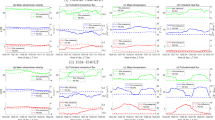We propose a small-scale transport model of the electric-discharge tree formation and analyze its implementation for a characteristic case of the thundercloud conditions. The following innovative features of the model can be emphasized: no connection to the spatial grid, high spatiotemporal resolution, and allowance for the asymmetry of the development of the positive and negative streamers and the time evolution of the discharge-channel parameters. The criterion of the streamer-to-leader transition, which is used in this work, is formulated in terms of the channel temperature and is based on the well-known mechanism of ionization-overheating instability, which is universal for the spark discharge. Within the framework of the described approach, a heated well-conducting leader channel is formed by combining the currents of tens of thousands of streamers, so that each of them initially has f negligible conductivity and a temperature that does not differ from the ambient temperature. The model bileader tree has electrodynamic characteristics that are intermediate between those known for the laboratory long spark and the developed lightning, which is expected for an “immature” lightning leader. The morphology and electrical parameters of the calculated discharge tree of the incipient model lightning leader agree with the modern data on the lightning-discharge development.
Similar content being viewed by others
References
D. I. Iudin, Radiophys. Quantum Electron., 60, No. 5, 374–394 (2017). https://doi.org/https://doi.org/10.1007/s11141-017-9807-x
T. C. Marshall, M. P. McCarthy, and W. D. Rust, J. Geophys. Res., 100, No. D4, 7097–7103 (1995). https://doi.org/https://doi.org/10.1029/95JD00020
L. B. Loeb, J. Geophys. Res., 71, No. 20, 4711–4721 (1966). https://doi.org/https://doi.org/10.1029/JZ071i020p04711
C. T. Phelps, J. Atmos. Sol.-Terr. Phys., 36, No. 1, 103–111 (1974). https://doi.org/https://doi.org/10.1016/0021-9169(74)90070-1
R. F. Griffiths and C. T. Phelps, J. Geophys. Res., 81, No. 21, 3671–3676 (1976). https://doi.org/https://doi.org/10.1029/JC081i021p03671
D. Petersen, M. Bailey, W. H. Beasley, et al., J. Geophys. Res., 113, No. D17, D17205 (2008). https://doi.org/https://doi.org/10.1029/2007JD009036
D. I. Iudin, S. S. Davydenko, V. M. Gotlib, et. al., Phys. Usp., 61, 766–778 (2018). https://doi.org/https://doi.org/10.3367/UFNe.2017.04.038221
D. I. Iudin, V. A. Rakov, A. A. Syssoev and A. A. Bulatov, Proc. Int. Symp. “Thunderstorm and Elementary Particle Acceleration” (TEPA-2018). September 17–20, 2018. Byurakan, Armenia, p. 118–136.
D. I. Iudin, V. A. Rakov, A. A. Syssoev, et al., Clim. Atm. Sci., 2, No. 1, 46 (2019). https://doi.org/https://doi.org/10.1038/s41612-019-0102-8
D. I. Iudin, V. A. Rakov, E. A. Mareev, et al., J. Geophys. Res. Atmos., 122, No. 12, 6416–6430 (2017). https://doi.org/https://doi.org/10.1002/2016jd026261
E. R. Mansell, D. R. MacGorman, C. L. Ziegler, and J.M. Straka, J. Geophys. Res. Atmos., 107, No.D9, 4075 2 (2002). https://doi.org/https://doi.org/10.1029/2000jd000244
E. R. Mansell, C. L. Ziegler, and E. C. Bruning, J. Atm. Sci., 67, No. 1, 171–194 (2010). https://doi.org/https://doi.org/10.1175/2009jas2965.1
J. A. Riousset, V. P.Pasko, P.R.Krehbiel, et al., J. Geophys. Res., 112, No. D15, D15203 (2007). https://doi.org/https://doi.org/10.1029/2006jd007621
H. Wang, F. Guo, T. Zhao, et al., Atmos. Res., 169, 183–190 (2016). https://doi.org/https://doi.org/10.1016/j.atmosres.2015.10.011
E. Williams in: V.Cooray, ed., The Lightning Flash, Institution of Engineering and Technology, London, p. 1–14 (2014). https://doi.org/https://doi.org/10.1049/PBPO069E_ch1
É. M. Bazelyan and Yu. P.Raizer, Spark Discharge, CRC Press, Boca Raton (1998).
M. A.Uman and R. E.Voshall, J. Geophys. Res., 73, 497–506 (1968). https://doi.org/https://doi.org/10.1029/JB073i002p00497
https://doi.org/https://doi.org/10.5281/zenodo.3560689
É. M. Bazelyan and Yu. P.Raizer, Lightning Physics and Lightning Protection, CRC Press, Boca Raton (2000).
I. Gallimberty, G. Bacchiega, A. Bondiou-Clergerie, et al., C. R. Physique, 3, 1335–1359 (2002). https://doi.org/https://doi.org/10.1016/S1631-0705(02)01414-7
V. A. Rakov and M. A.Uman, Lightning: Physics and Effects, Cambridge University Press, New York (2003).
Yu.P.Raizer, Physics of Gas Discharge [in Russian], Intellekt, Dolgoprudny (2009).
V. A. Rakov, J. Geophys. Res., 103, No. D2, 1879–1887 (1998). https://doi.org/https://doi.org/10.1029/97jd03116
M.N. O. Sadiku, Elements of Electromagnetics. 7th ed., Oxford University Press, Oxford (2018).
O. A. van der Velde, J. Geophys. Res. Atmos., 118, No. 24, 13504–13519 (2013). https://doi.org/https://doi.org/10.1002/2013jd020257
G. Maslowski and V. A. Rakov, J. Geophys. Res., 111, No. D14, D14110 (2006). https://doi.org/https://doi.org/10.1029/2005jd006858
A. Luque and E. Ute, New J. Phys., 16, No. 1, 013039 (2014). https://doi.org/https://doi.org/10.1088/1367-2630/16/1/013039
J. L. Bentley, Commun. ACM, 18, No. 9, 509–517 (1975). https://doi.org/https://doi.org/10.1145/361002.361007
Author information
Authors and Affiliations
Corresponding author
Additional information
Translated from Izvestiya Vysshikh Uchebnykh Zavedenii, Radiofizika, Vol. 63, No. 2, pp. 135–154, February 2020.
Rights and permissions
About this article
Cite this article
Bulatov, A.A., Iudin, D.I. & Sysoev, A.A. Self-Organizing Transport Model of a Spark Discharge in a Thunderstorm Cloud. Radiophys Quantum El 63, 124–141 (2020). https://doi.org/10.1007/s11141-020-10041-z
Received:
Accepted:
Published:
Issue Date:
DOI: https://doi.org/10.1007/s11141-020-10041-z




